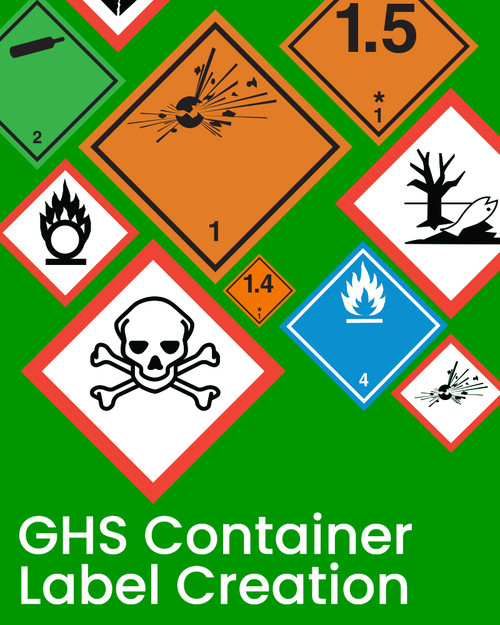
Sample List of Companies We've Served

The Globally Harmonized System of Classifications and Labeling of Chemicals (GHS) was created by the United Nations in order to have a universal standard of chemical regulations and hazard classifications throughout the world. An important requirement of this system is the change from Material Safety Data Sheets (MSDS’s) to GHS-compliant Safety Data Sheets (SDS’s). With the 16-section format, SDS’s will classify chemical mixtures by physical, health and environmental hazards.
To prepare for the GHS regulations, the Occupational Safety and Health Administration (OSHA) revised the Hazard Communication Standard (HCS). Standards require that hazards be depicted through Pictograms, Hazard Statements (Risk and Safety Phrases), and Signals Words that will need to appear on SDS’s and chemical product and container labels.
GHS Conversion Services can help alleviate this stress by creating GHS-compliant SDS’s and container labels for you, allowing you to focus on your work and eliminate long hours of overtime. With over 55 years of combined experience in authoring MSDS’s and other various regulatory paperwork, GHS Conversion Services retains the skill set and knowledge required to author your company’s SDS’s and container labels to the proper standards.
GHS Conversion Services will convert your MSDS’s to the GHS-compliant SDS’s, as well as prepare separate container labels that are compliant with the GHS label format. All services are conducted at a flat rate per SDS to assure that no surprise fees are added in the event of GHS-mandated format changes. Once completed, SDS’s and container labels will be sent to you and/or your chemical blender in PDF format. Any required edits due to formulation changes will be managed with a small service fee, due to the necessary changes needing to be made to SDS’s. Services and fees are listed below.
Featured Products
-
 Was: $220.00Now: $198.00
Was: $220.00Now: $198.00 -

GHS SDS Creation (From Scratch)
Was: $330.00Now: $297.00 -

GHS Container Label Creation
Was: $82.50Now: $74.25 -

GHS SDS Subsequent Edits (Formulation Change)
Was: $16.50Now: $14.85
In order to quickly and accurately perform our conversion services, we require certain information about the products which MSDS’s need to be converted to SDS’s. Often, chemical blends are formulated in such a way that proprietary information can be concealed to protect trade secrets. To fully ensure that your SDS’s are prepared quickly and correctly, while still protecting your trade secrets, we will need the following information:
REQUIRED INFORMATION
1. Current Product/Chemical Formula (Blending Protocol)
2. Current MSDS (if available)
3. pH of the Product/Chemical (at 10% in DI water)
4. Company Logo (to appear on SDS’s and Container Labels)
OPTIONAL INFORMATION
1. Desired Font and Color Scheme
2. Non-Disclosure Agreement (optional)*
*GHS Conversion Services is committed to protecting your trade secrets and proprietary information. To ensure our commitments, we recommend that a Non-Disclosure Agreement (NDA) be formed between your company and GHS Conversion Services. An NDA acts as an understanding between your company and GHS Conversion Services in which GHS Conversion Services agrees to not use any confidential information pertaining to your company for any purpose except to evaluate and engage in discussions concerning business conducted between your company and GHS Conversion Services.
The following annex authored by the United Nations in 2007 details the specific requirements needed to prepare an SDS in accordance with the Globally Harmonized System of Classifications and Labeling of Chemicals. Use of the “Guidance on the Preparation of Safety Data Sheets (SDS)” should support compliance with competent authority requirements. The annex covers the strict formatting specifications and offers detailed instructions on the content of each of the 16 sections, which includes standards on the correct way to communicate the hazards of your chemical product.
Along with the PDF of the “Annex 4: Guidance on the Preparation of Safety Data Sheets (SDS)”, we have also provided a brief overview of the 16-section format required under the GHS.
The 16 Sections of an SDS are as follows:
Section 1, Identification: Includes all chemical product identifiers, supplier, manufacturer or distributor name and detailed contact information, recommended use, and restrictions on use, and emergency contact phone number.
Section 2, Hazard identification: Includes exact classification of the chemical substance, all hazards, and required GHS label elements including precautionary statements and pictograms.
Section 3, Composition/information on Ingredients: Includes all information on chemical ingredients and information on complex substances. If applicable, the Confidential Business Information rules take priority, and confidential information about the chemical product may be omitted.
Section 4, First-aid measures: Includes advice on first-aid measures and symptoms and effects of exposure to chemical (acute and delayed) and indication of need for immediate medical attention.
Section 5, Fire-fighting measures: Includes the requirements for extinguishing a fire caused by the chemical substance and specific hazards arising from chemical fire.
Section 6, Accidental release measures: Includes the emergency procedures needed to respond to spills or leaks of chemical product, environmental precautions, and proper methods of containment and cleanup.
Section 7, Handling and storage: Includes guidelines for safe handling practices of chemical substance and safe storage, including incompatibilities.
Section 8, Exposure controls/personal protection: Includes “occupational exposure limits” of workplace, specific protection and prevention measures, and how to minimize exposure and risk.
Section 9, Physical and chemical properties: Provides details on each property of the chemical material.
Section 10, Stability and reactivity: Provides all details in regards to chemical stability and possibility of hazardous reactions.
Section 11, Toxicological information: Primary used by medical, health and safety professionals, this section includes all toxological health effects and all available data to support the information.
Section 12, Ecological information: Includes the evaluation of the environmental impact of the chemical substance on the environment, if released.
Section 13, Disposal considerations: Provides information on proper disposal of chemical substance including specific precautions.
Section 14, Transport information: Includes all classification information for the transporting or shipment of the chemical product.
Section 15, Regulatory information: Includes any additional regulatory information not found elsewhere in the SDS.
Section 16, Other information: Includes the date of preparation or last revision, a key to all abbreviations or acronyms, and sources for data used to gather information for the SDS.
Be careful about your SDS Sheets as the penalties are set by OSHA as listed below:
OSHA Penalties
Be careful about your SDS Sheets as the penalties are set by OSHA as listed below:
| Type of Violation | Penalty |
| Serious Other-Than-Serious Posting Requirements |
$16,131 per violation |
| Failure to Abate | $16,131 per day beyond the abatement date |
| Willful or Repeated | $161,323 per violation |
State Plan States
States that operate their own Occupational Safety and Health Plans are required to adopt maximum penalty levels that are at least as effective as Federal OSHA’s.
For More Assistance
OSHA offers a variety of options for employers looking for compliance assistance.
The On-site Consultation Program provides professional, high-quality, individualized assistance to small businesses at no cost.
OSHA also has compliance assistance specialists in most of our 85 Area Offices across the nation who provide robust outreach and education programs for employers and workers.
For more information, please contact the Regional or Area Office nearest to you.
From https://www.osha.gov/penalties/
With all of the health and safety risks involved, we understand that the process of converting your outdated MSDS to GHS-compliant Safety Data Sheets can be stressful – especially if you’re already dealing with delayed shipments or facing expensive fines. At GHS Conversion Services, we specialize in creating GHS-compliant SDS and updating container labels for all of your chemical product needs. This includes ensuring that your SDS and container labels are OSHA-compliant with the revised HCS standards. Contact us today to request a quote to learn more. With over 55 years of combined experience, we are focused on guaranteeing your SDS and container labels are up-to-date, all while protecting your trade secrets and proprietary information. Contact us today!
Contact Us


